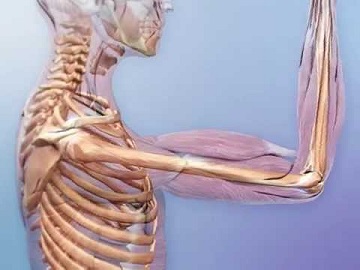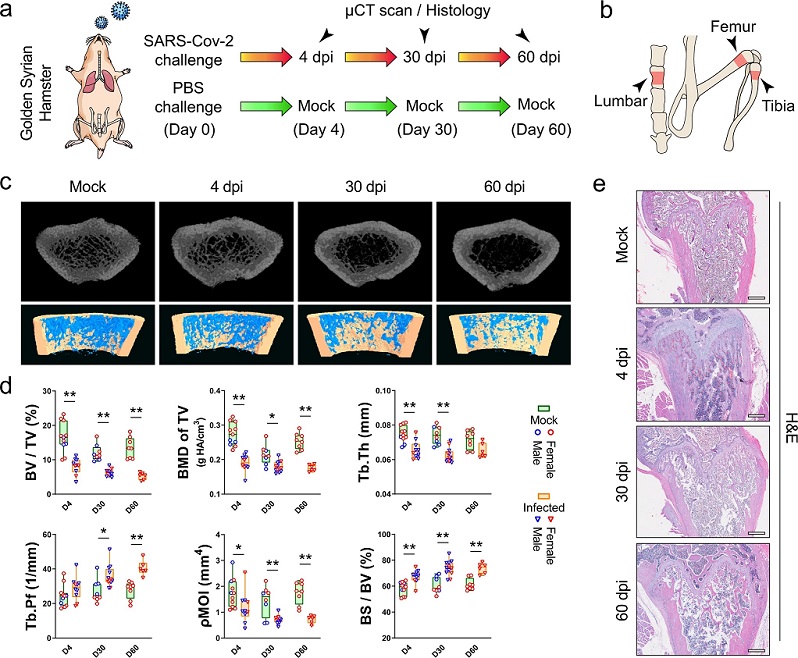BREAKING! New Hong Kong Study Reveals That SARS-CoV-2 Infections Also Causes Inflammatory Bone Loss Leading To Long COVID Skeletal Health Issues!
Source: Medical News - Long COVID May 25, 2022 3 years, 7 months, 5 days, 16 hours, 9 minutes ago
Long COVID: A new study by researchers from the School of Clinical Medicine, Li Ka Shing Faculty of Medicine, the University of Hong Kong has found that SARS-CoV-2 infections also causes inflammatory bone loss leading to Long COVID skeletal health issues!

A past multi-center study showed that COVID-19 patients requiring intensive care had significantly lower bone mineral density (BMD) than those who were managed in non-intensive care settings.
https://pubmed.ncbi.nlm.nih.gov/33301962/
Also, another clinical study found that the number of severe clinical incidence was significantly higher in patients with lower BMD compared to those with higher BMD, therefore vertebral BMD is a strong independent predictor of mortality in COVID-19 patients.
https://www.sciencedirect.com/science/article/pii/S1094695021000615
It has also been reported that about 24% of long COVID patients have bone ache or burning, with the symptoms lasting for up to 7 months after the onset of COVID-19.
https://www.thelancet.com/journals/eclinm/article/PIIS2589-5370(21)00299-6/fulltext
However, despite these emerging evidence on the long-term complications of COVID-19, very limited serial investigations have been conducted on skeletal system involvement in the post-recovery phase. This is not unexpected because in COVID-19, patients either succumb or recover from the acute phase. In patients who recover from COVID-19, the focus on follow-up is usually limited to the respiratory, cardiac, and neurological functions which are well reported in the literature, rather than skeletal pathologies which typically do not manifest in the acute phase and therefore may be neglected. Moreover, since severe COVID-19 is most often found in elderly patients and those with comorbidities, including those on chronic corticosteroid and immunosuppressive drugs, the disease-associated bone changes in these patients who may already have osteoporosis before the infection may not be appreciated.
The
Long COVID study team characterized the effects of severe acute respiratory syndrome coronavirus 2 (SARS-CoV-2) infection on bone metabolism in an established golden Syrian hamster model for COVID-19.
It was found that the SARS-CoV-2 virus causes significant multifocal loss of bone trabeculae in the long bones and lumbar vertebrae of all infected hamsters.
The study findings also revealed that the bone loss is associated with SARS-CoV-2-induced cytokine dysregulation, as the circulating pro-inflammatory cytokines not only upregulate osteoclastic differentiation in bone tissues, but also trigger an amplified pro-inflammatory cascade in the skeletal tissues to augment their pro-osteoclastogenesis effect.
 a Golden Syrian hamsters were either treated with SARS-CoV-2 or PBS (Mock), followed by a μCT scan and histology analysis at 4, 30, and 60 days post-infection (dpi). b The regions of interest for μCT evaluation of bone density included the distal metaphysis of the femur, proximal metaphysis of tibia, and lumbar vertebrae. c Representative μCT images showing the reduction in trabecular bone volume in the femurs of the SARS-CoV-2-infected hamsters. d Corresponding measurements of trabecular bone volume fraction (BV/TV), bone mineral density (BMD of TV), trabecular thickness (Tb.Th), trabecular pattern factor (Tb.Pf), polar moment of inertia (pMOI), and specific bone surface (BS/BV). Mock: n = 11 (D4), 8 (D30), 8 (D60); Infected: n = 10 (D4), 12 (D30), 6 (D60). e Representative H&E staining images showing the cancellous bone structures in the femurs of the SARS-CoV-2-infected hamsters (n = 4, scale bars = 500 µm). Data were presented as box plots with whiskers from minima to maxima, the central line at the 50th percentile, and the ends of the box at the 25th and 75th percentiles. *P < 0.05, **P < 0.01 by two-way ANOVA with Bonferroni’s multiple comparisons test.
a Golden Syrian hamsters were either treated with SARS-CoV-2 or PBS (Mock), followed by a μCT scan and histology analysis at 4, 30, and 60 days post-infection (dpi). b The regions of interest for μCT evaluation of bone density included the distal metaphysis of the femur, proximal metaphysis of tibia, and lumbar vertebrae. c Representative μCT images showing the reduction in trabecular bone volume in the femurs of the SARS-CoV-2-infected hamsters. d Corresponding measurements of trabecular bone volume fraction (BV/TV), bone mineral density (BMD of TV), trabecular thickness (Tb.Th), trabecular pattern factor (Tb.Pf), polar moment of inertia (pMOI), and specific bone surface (BS/BV). Mock: n = 11 (D4), 8 (D30), 8 (D60); Infected: n = 10 (D4), 12 (D30), 6 (D60). e Representative H&E staining images showing the cancellous bone structures in the femurs of the SARS-CoV-2-infected hamsters (n = 4, scale bars = 500 µm). Data were presented as box plots with whiskers from minima to maxima, the central line at the 50th percentile, and the ends of the box at the 25th and 75th percentiles. *P < 0.05, **P < 0.01 by two-way ANOVA with Bonferroni’s multiple comparisons test.
The study findings suggest that pathological bone loss may be a neglected complication which warrants more extensive investigations during the long-term follow-up of COVID-19 patients.
The study team stressed that the benefits of potential prophylactic and therapeutic interventions against pathological bone loss should be further evaluated.
The study findings were published in the peer reviewed journal: Nature Communications.
https://www.nature.com/articles/s41467-022-30195-w
The study team was led by Professor Dr Kelvin Yeung Wai-kwok and Dr Jasper Chan Fuk-woo from the LKS Faculty of Medicine, The University of Hong Kong (HKUMed).
The study was the first to date that discovered that SARS-CoV-2 infection can cause inflammatory activation of bone resorption cells, leading to severe bone loss during the acute and post-recovery phases of COVID-19.
The study findings also provide insights into the possible long-term complications of COVID-19 with regards to the skeletal system.
Current data shows that in addition to pulmonary infection, extrapulmonary complications of different organ systems in the long-term post-acute sequelae of SARS-CoV-2 infection, or ‘long COVID’, are also being increasingly recognized in patients with COVID-19.
Unfortunately however, the full spectrum of clinical manifestations, especially the influence of SARS-CoV-2 infection on bone metabolism, has yet to be fully understood till now.
The study team aim was to study the effects of SARS-CoV-2 infection on bone metabolism in Syrian hamsters that were intranasally challenged with SARS-CoV-2. Upon infection, their bone tissues were collected serially and utilizing three-dimensional micro-computerized tomography (μCT) scans, the study team identified that the SARS-CoV-2 infection had induced severe bone loss from 20% to 50% progressively in particular to the trabecular bone in the long bones and lumbar vertebrae.
Interestingly, this effect extended from the acute phase to the chronic phase of infection. The pathological osteopenia was found to be associated with the inflammatory activation of osteoclasts (a kind of cell responsible for bone resorption). The cytokine dysregulation induced by SARS-CoV-2 not only upregulated osteoclastic differentiation in bone tissues, but also triggered an amplified pro-inflammatory cascade in the skeletal tissues to augment their pro-osteoclastogenesis effects.
Professor Dr Kelvin Yeung told Thailand
Medical News, “Our study finding is the first in the world to report the effects of SARS-CoV-2 on bone metabolism using a well-established Syrian hamster model that closely mimics COVID-19 in humans.”
Importantly, the study findings indicate that the pathological bone loss may be an important but neglected complication, which warrants more extensive investigations during the long-term follow-up of COVID-19 patients.
For the latest research findings on
Long COVID, keep on logging to Thailand Medical News.

 a Golden Syrian hamsters were either treated with SARS-CoV-2 or PBS (Mock), followed by a μCT scan and histology analysis at 4, 30, and 60 days post-infection (dpi). b The regions of interest for μCT evaluation of bone density included the distal metaphysis of the femur, proximal metaphysis of tibia, and lumbar vertebrae. c Representative μCT images showing the reduction in trabecular bone volume in the femurs of the SARS-CoV-2-infected hamsters. d Corresponding measurements of trabecular bone volume fraction (BV/TV), bone mineral density (BMD of TV), trabecular thickness (Tb.Th), trabecular pattern factor (Tb.Pf), polar moment of inertia (pMOI), and specific bone surface (BS/BV). Mock: n = 11 (D4), 8 (D30), 8 (D60); Infected: n = 10 (D4), 12 (D30), 6 (D60). e Representative H&E staining images showing the cancellous bone structures in the femurs of the SARS-CoV-2-infected hamsters (n = 4, scale bars = 500 µm). Data were presented as box plots with whiskers from minima to maxima, the central line at the 50th percentile, and the ends of the box at the 25th and 75th percentiles. *P < 0.05, **P < 0.01 by two-way ANOVA with Bonferroni’s multiple comparisons test.
a Golden Syrian hamsters were either treated with SARS-CoV-2 or PBS (Mock), followed by a μCT scan and histology analysis at 4, 30, and 60 days post-infection (dpi). b The regions of interest for μCT evaluation of bone density included the distal metaphysis of the femur, proximal metaphysis of tibia, and lumbar vertebrae. c Representative μCT images showing the reduction in trabecular bone volume in the femurs of the SARS-CoV-2-infected hamsters. d Corresponding measurements of trabecular bone volume fraction (BV/TV), bone mineral density (BMD of TV), trabecular thickness (Tb.Th), trabecular pattern factor (Tb.Pf), polar moment of inertia (pMOI), and specific bone surface (BS/BV). Mock: n = 11 (D4), 8 (D30), 8 (D60); Infected: n = 10 (D4), 12 (D30), 6 (D60). e Representative H&E staining images showing the cancellous bone structures in the femurs of the SARS-CoV-2-infected hamsters (n = 4, scale bars = 500 µm). Data were presented as box plots with whiskers from minima to maxima, the central line at the 50th percentile, and the ends of the box at the 25th and 75th percentiles. *P < 0.05, **P < 0.01 by two-way ANOVA with Bonferroni’s multiple comparisons test.